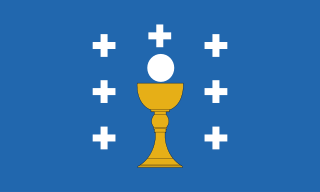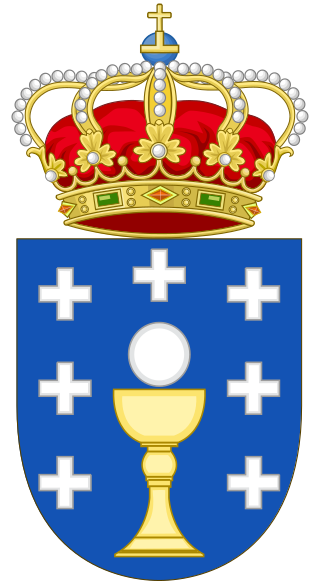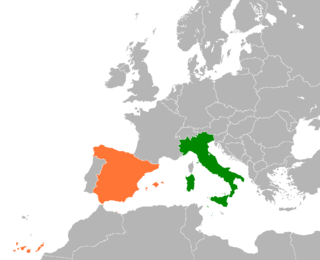
Galicia is an autonomous community of Spain and historic nationality under Spanish law. Located in the northwest Iberian Peninsula, it includes the provinces of A Coruña, Lugo, Ourense, and Pontevedra.

Spain, officially the Kingdom of Spain, is a country in Southwestern Europe with territories in North Africa. Featuring the southernmost point of continental Europe, it is the largest country in Southern Europe and the fourth-most populous European Union member state. Spanning across the majority of the Iberian Peninsula, its territory also includes the Canary Islands, in the Eastern Atlantic Ocean, the Balearic Islands, in the Western Mediterranean Sea, and the autonomous cities of Ceuta and Melilla, in Africa. Peninsular Spain is bordered to the north by France, Andorra, and the Bay of Biscay; to the east and south by the Mediterranean Sea and Gibraltar; and to the west by Portugal and the Atlantic Ocean. Spain's capital and largest city is Madrid, and other major urban areas include Barcelona, Valencia, Seville, Zaragoza, Málaga, Murcia and Palma de Mallorca.

Pontevedra is a city in the autonomous community of Galicia, in northwestern Spain. It is the capital of both the Comarca and Province of Pontevedra, and the capital of the Rías Baixas. It is also the capital of its own municipality which is often considered an extension of the actual city.
The Kingdom of Romania, under the rule of King Carol II, was initially a neutral country in World War II. However, Fascist political forces, especially the Iron Guard, rose in popularity and power, urging an alliance with Nazi Germany and its allies. As the military fortunes of Romania's two main guarantors of territorial integrity—France and Britain—crumbled in the Fall of France, the government of Romania turned to Germany in hopes of a similar guarantee, unaware that Germany, in the supplementary protocol to the 1939 Molotov–Ribbentrop Pact, had already granted its blessing to Soviet claims on Romanian territory.

The Galician Nationalist Bloc is a political party from Galicia, formed with the merger of a series of left-wing Galician nationalist parties. It is self-defined as a "patriotic front".

Almost every country in the world participated in World War II. Most were neutral at the beginning, but only a relative few nations remained neutral to the end. The Second World War pitted two alliances against each other, the Axis powers and the Allied powers. It is estimated that 74 million people died, with estimates ranging from 40 million to 90 million dead. The main Axis powers were Nazi Germany, the Empire of Japan, and the Kingdom of Italy; while the United Kingdom, the United States, the Soviet Union and China were the "Big Four" Allied powers.

The Allies, formally referred to as the United Nations from 1942, were an international military coalition formed during World War II (1939–1945) to oppose the Axis powers. Its principal members by the end of 1941 were the "Big Four" – the United Kingdom, United States, Soviet Union, and China.

The Kingdom of Galicia was a political entity located in southwestern Europe, which at its territorial zenith occupied the entire northwest of the Iberian Peninsula. In the early 10th century, the Kingdom of Galicia was formed following the division of the Kingdom of Asturias after the death of Alfonso III in 910. His sons split the kingdom, with Ordoño II inheriting Galicia. While Galicia became a distinct political entity, it remained closely tied to the Leonese and Asturian realms through dynastic connections. Later, Ordoño II would integrate Galicia into the Kingdom of León when he inherited the latter. Though the Kingdom of Galicia had moments of semi-independence, it was typically seen as part of the Kingdom of León. Compostela became the capital of Galicia in the 11th century, while the independence of Portugal (1128) determined its southern boundary. The accession of Castilian King Ferdinand III to the Leonese kingdom in 1230 brought Galicia under the control of the Crown of Castile.

The Statute of Autonomy of Galicia of 1981 is the current basic institutional norm of Galicia. The Galician Government, Parliament and High Court of Galicia are regulated by it.
La Voz de Galicia is a Spanish daily newspaper owned by the Corporación Voz de Galicia. La Voz is highest circulation newspaper in Galicia and the eighth-highest circulation general-interest daily newspaper in Spain. It is written primarily in Spanish with Galician used in the cultural and opinion sections.

During World War II, the Spanish State under Francisco Franco espoused neutrality as its official wartime policy. This neutrality wavered at times, and "strict neutrality" gave way to "non-belligerence" after the Fall of France in June 1940. Franco wrote to Adolf Hitler offering to join the war on 19 June 1940 in exchange for help building Spain's colonial empire. Later in the same year Franco met with Hitler in Hendaye to discuss Spain's possible accession to the Axis Powers. The meeting was not successful, but Franco did help the Axis—whose members Italy and Germany had supported him during the Spanish Civil War (1936–1939)—in various ways.

El Bierzo is a comarca in the province of León, Spain. Its capital is the town of Ponferrada. Other major towns are Bembibre and Villafranca del Bierzo, the historical capital.

The Maquis were Spanish guerrillas who waged an irregular warfare against the Francoist dictatorship within Spain following the Republican defeat in the Spanish Civil War until the early 1960s, carrying out sabotage, robberies and assassinations of alleged Francoists as well as contributing to the fight against Nazi Germany and the Vichy regime in France during World War II. They also took part in occupations of the Spanish embassy in France.

The neutral powers were countries that remained neutral during World War II. Some of these countries had large colonies abroad or had great economic power. Spain had just been through its civil war, which ended on 1 April 1939 —a war that involved several countries that subsequently participated in World War II.

Foreign relations of the Axis powers includes states which were not officially members of the Axis but had relations with one or more Axis members.

Italy–Spain relations are the interstate relations between Italy and Spain. Both countries established diplomatic relations some time after the unification of Italy in 1860.
Galician Americans are Americans of Galician descent.
The Wolfram Crisis was a diplomatic conflict during World War II between Francoist Spain and the Allied powers, which sought to block Spanish exports of tungsten ore to Nazi Germany. "Wolfram" is an alternate name for tungsten, a strategic material used in anti-tank weapons and machine tools. Most of the wolframite mines in Europe, such as the Barruecopardo mine, are in northwestern Spain and northern Portugal.

The Natural Park of the Marismas de Alba, the Alba Marsh or the Xunqueira de Alba, is a natural park and wetland in the city of Pontevedra in Spain, and one of the few Marshes in the Ria de Pontevedra. It is a park used as a place for walking, cycling and observing the fauna and flora.

The historic centre of Pontevedra (Spain) is the oldest part of the city. It is the second most important old town in Galicia after Santiago de Compostela, and was declared a historic-artistic complex on 23 February 1951.
















